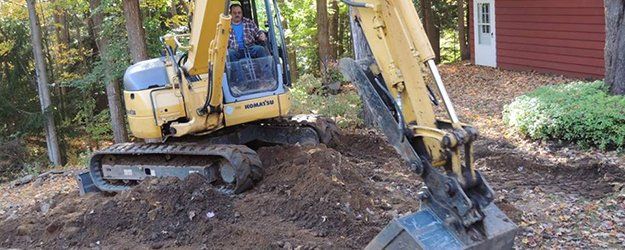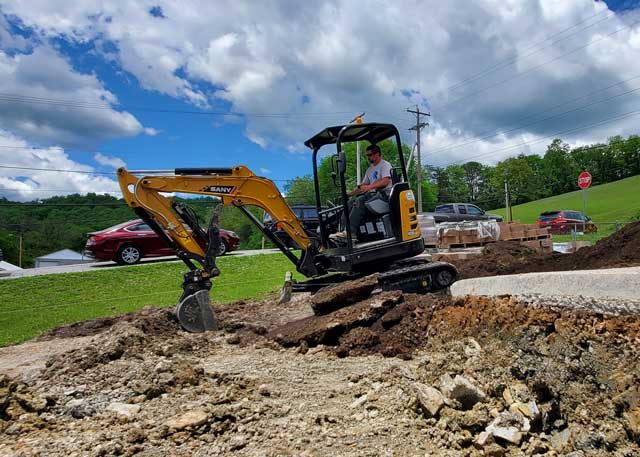Lancaster Excavation - Specialist Excavation Solutions in Lancaster, OH
Lancaster Excavation - Specialist Excavation Solutions in Lancaster, OH
Blog Article
Introducing the Art of Excavation: Pro Tips for Safe and Effective Excavating
In the realm of excavation, the proficiency of secure and productive excavating is an art kind that needs adherence, accuracy, and understanding to recognized techniques. As dirt is turned and earth is moved, the ins and outs of excavation expose themselves, demanding a keen understanding of tools, dirt make-up, safety and security protocols, and environmental factors to consider. The competence required to navigate these components properly can suggest the difference between an effective excavation job and a prospective disaster. By untangling the layers of this complex process, a world of methods and insights awaits those seeking to raise their excavation skills to brand-new elevations.
Relevance of Appropriate Equipment
To guarantee the security and efficiency of any kind of excavation job, using the ideal equipment is paramount. Excavation tasks vary in extent and intricacy, ranging from little domestic landscape design work to large-scale building and construction undertakings.
Excavators are basic pieces of equipment in any digging operation. These versatile equipments can be found in various sizes to match different job requirements. Small excavators are ideal for smaller sized tasks, while bigger excavators tackle a lot more comprehensive tasks effectively. Backhoes are an additional essential devices type, incorporating the functions of a loader and an excavator in one maker. They are important for jobs needing flexibility and ability to move.
Excavators stand out in jobs that require pressing huge amounts of soil or particles. By spending in the ideal devices, excavation projects can be finished safely, on time, and with precision.
Comprehending Soil Make-up
A comprehensive understanding of dirt make-up is fundamental for performing excavation projects with accuracy and safety and security. Understanding the different types of soil is vital as it directly influences excavation techniques, devices choice, and general project efficiency.
Sand particles are the biggest and offer excellent water drainage but supply little cohesion. Silt particles are smaller sized than sand but bigger than clay, using moderate water drainage and cohesion. Clay particles are the tiniest and give high communication but inadequate drain. Raw material, such as decomposing plant product, impacts soil fertility and stability.
Before starting excavation, carrying out soil examinations to identify its composition and characteristics is important. This information aids in choosing the appropriate tools, executing safety measures, and developing excavation approaches tailored to the specific dirt conditions - lancaster excavation. By recognizing soil make-up, excavation professionals can boost job end results while making sure safety and adherence to ideal practices
Safety And Security Steps and Methods
Understanding dirt composition is the cornerstone upon which precaution and procedures for excavation tasks are built, making certain the well-being of employees and the success of the undertaking. There are several essential procedures that have to be implemented to alleviate threats and prevent accidents. when it comes to security during excavation.
Firstly, before any type of digging starts, a comprehensive examination of the site ought to be carried out to determine any kind of possible dangers such as below ground energies, unpredictable dirt conditions, or neighboring frameworks that could pose a risk. It is vital to have a competent person supervise you could try these out the excavation process to make sure that all security procedures are complied with purely.
Moreover, all employees involved in the excavation needs to be effectively learnt risk-free excavating practices and the appropriate procedure of equipment. Personal safety equipment (PPE) such as tough hats, high presence clothing, handwear covers, and safety and security boots should be used in any way times to minimize the risk of injuries. septic ohio. Regular safety meetings and toolbox talks must additionally be performed to maintain all workers informed about possible risks and strengthen risk-free job practices. By adhering to these safety visit here steps and protocols, excavation tasks can be finished effectively and without event.
Reliable Excavation Planning
When beginning on an excavation project, careful planning is important to ensure efficiency, safety, and effective results. Reliable excavation planning entails several vital actions that are critical for the smooth execution of the task.
When the website assessment is full, the next step is to develop a clear timeline and schedule for the excavation tasks. This consists of identifying the series of tasks, equipment requirements, and manpower allotment. Proper organizing aids avoid hold-ups and makes certain that the job remains on track.

In addition, communication among all team members is extremely important throughout the planning stage. Clear instructions, normal updates, and efficient coordination are necessary for a successful excavation task. By investing time and effort in meticulous planning, excavation groups can considerably boost efficiency, minimize dangers, and achieve effective end results.

Taking Care Of Environmental Considerations
With increasing focus on ecological sustainability in building practices, handling environmental factors to consider has become a crucial aspect of excavation projects. Excavation activities have the potential to impact the surrounding setting with soil erosion, debris runoff, habitat disturbance, and contamination of water sources. To our website reduce these dangers, it is vital to implement finest methods that prioritize environmental security.

In addition, appropriate waste monitoring is critical to avoid soil and water contamination. Executing procedures for the disposal of unsafe materials, recycling of waste materials, and lessening the use of hazardous chemicals can considerably minimize the ecological effect of excavation projects. By integrating these practices into excavation planning and implementation, construction companies can make sure that their tasks are not only safe and productive however also environmentally liable.
Final Thought
To conclude, grasping the art of excavation requires a complete understanding of correct devices, soil make-up, precaution, and reliable preparation. By complying with these guidelines and considering environmental factors, excavations can be performed securely and successfully. It is essential to focus on security and performance in every digging project to make certain effective end results.
As soil is turned and planet is moved, the intricacies of excavation expose themselves, requiring an eager understanding of devices, soil make-up, safety and security procedures, and ecological factors to consider.To make certain the safety and efficiency of any kind of excavation project, using the proper tools is extremely important.A thorough understanding of dirt make-up is essential for carrying out excavation projects with precision and security. Understanding the various types of dirt is crucial as it directly influences excavation techniques, tools selection, and general task efficiency. By comprehending dirt make-up, excavation professionals can improve project outcomes while making sure safety and security and adherence to best practices.
Report this page